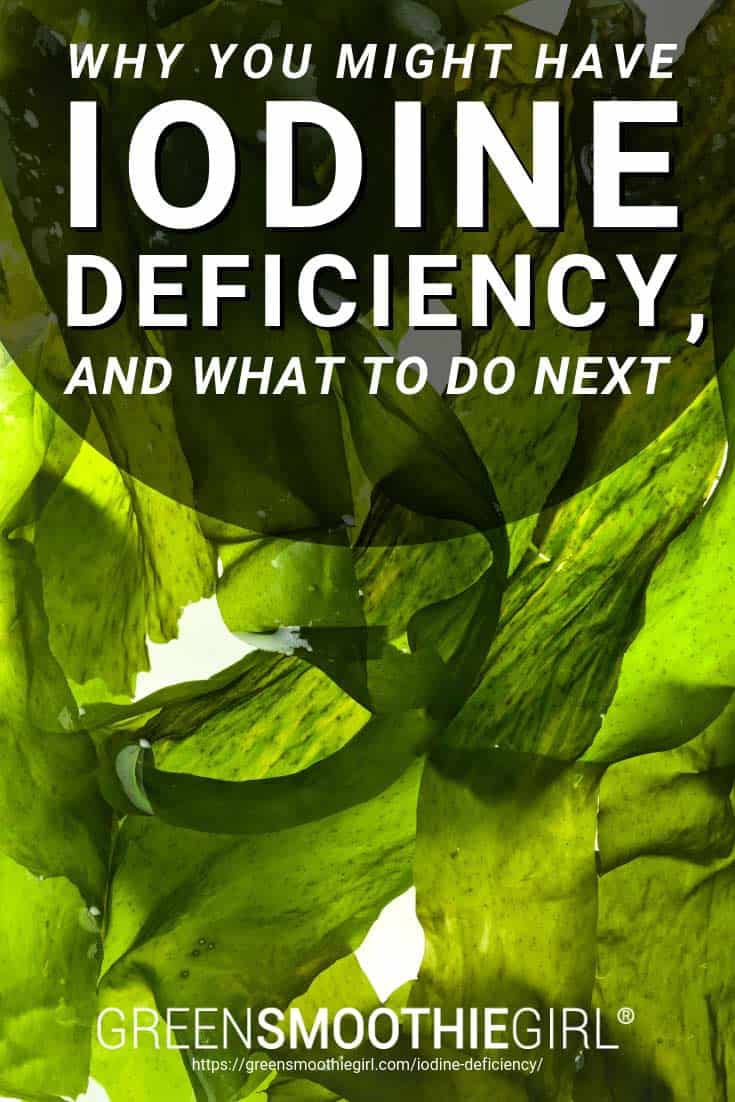Why You Might Have Iodine Deficiency, And What To Do Next
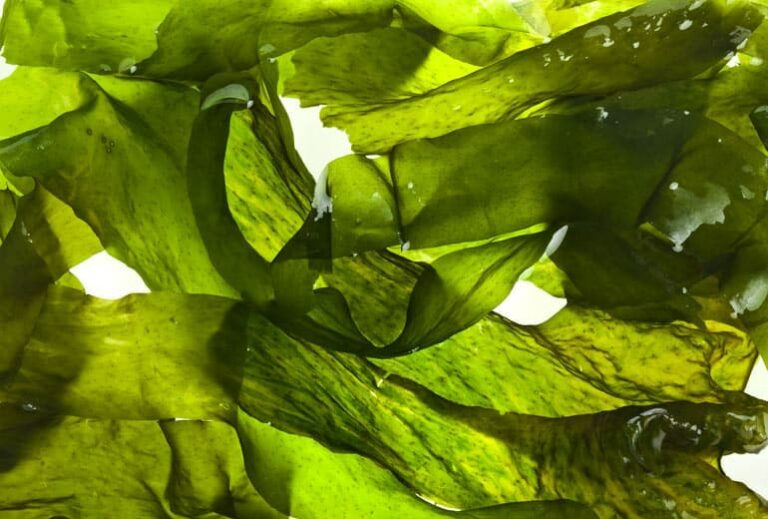
Iodine — most of us know it as the stuff that gets added to our salt. You know, “This salt contains iodide, a necessary ingredient.”
But as it turns out, that salt label is the understatement of the year. Even if you’re buying iodized salt, you may well be one of more than 2.5 billion people worldwide who have an iodine deficiency,1 known to cause a number of health issues from fatigue, weight gain, and memory problems to thyroid and hormonal imbalances.
In this post:
- Benefits and Uses for Iodine
- Signs You Might Have an Iodine Deficiency
- Why Are So Many People Iodine Deficient?
- Iodine-Rich Foods
- How Much Iodine Do I Need for Optimal Health?
- Supplementing with Iodine
- Common Myths and Misconceptions About Iodine
- How to Test Your Iodine Levels
- Summary: Why Iodine Matters
Skeptical? You won’t be when you learn more about the benefits of iodine, why most of us are deficient, and a few pervasive myths.
Benefits and Uses for Iodine
Just how important is iodine?
Albert Szent Györgyi, the medical student who discovered Vitamin C and went on to win the Nobel Prize for his breakthrough work in biochemistry, put it this way:
"When I was a medical student, iodine in the form of KI [potassium iodide] was the universal medicine. … We students used to sum up the situation in this little rhyme: ‘If ye don’t know where, what, and why, prescribe ye then K and I.’”
Gyorgyi's contemporaries were learning that near-universal iodine deficiencies could account for numerous mystery illnesses. Today, there’s less mystery surrounding exactly how iodine works in the body--and more evidence of its importance to human health.
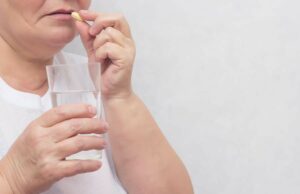
Iodine is a super powerful chemical that has the potential to help you in a lot of ways.
IMPORTANT: Iodine is isn’t like Vitamin C, where your body simply sloughs off the excess. Not everyone needs iodine, and you should be tested for deficiency before self-administering. Too much iodine can be just as problematic as too little. Before you make a beeline to Amazon for a kelp supplement, it’s important to consider your thyroid health (e.g., if you have Hashimoto’s or Graves’ disease, you should not supplement with iodine unless you’re medically supervised).
Brain Development and Cognition
Iodine deficiency is the leading recognized cause of cognitive delays, making it extra important for pregnant women (who need to consume 50%-80% more iodine than other adults), lactating women, and infants.
The World Health Organization states3 in no uncertain terms that iodine deficiency during pregnancy is “the world’s most prevalent, yet easily preventable, cause of brain damage.”
On a more hopeful note, one Australian study4 showed that supplementing with iodine significantly helped children with reasoning and perceptual skills.
Thyroid Health and Hormone Production
Iodine is best known for its role in thyroid health and hormone production, and for good reason! Your thyroid is the gatekeeper that produces and controls a whole host of important hormones, including metabolic hormones and growth hormones.
And iodine is the critical factor in whether or not these hormones (most notably triiodothyronine/T3, and thyroxine/T4) are produced in sufficient quantities.
A healthy thyroid5 means proper digestion of food, a steady heartbeat, sexual wellness, proper tissue and bone growth, and the ability to maintain a healthy weight.
Bone and Muscle Health
Iodine also plays a critical role in the formation of bones, teeth, and rate of growth in the human body because of its role in absorbing calcium and regulating calcium levels.
Iodine-related thyroid problems figure in bone health, too. There’s a well established link between thyroid disease and proper calcium absorption.6 An unhealthy thyroid can’t regulate calcium levels in the bloodstream, leading to problems with not only the bones and teeth but also the muscles — including the heart.
Antiseptic and Water Purifier
Iodine has natural sterilization and antiseptic properties. Iodine solutions are often used to sterilize wounds, reduce the risk of wound infection, and promote healing.7
Iodine can also be used to purify drinking water because of its ability to destroy bacteria, viruses, and other dangerous microscopic organisms. Iodine tablets are the method of choice for many survivalists and outdoor enthusiasts.8
Antioxidant and Anti-Inflammatory Effect
Iodine is also a powerful antioxidant, rivaling Vitamin C for its role in eradicating free-radicals, pathogens, and waste products that damage, inflame, or destroy healthy cells.
Iodine keeps volatile, dangerous compounds from binding to cells or mutating DNA. It’s one of the reasons that iodine consumption is associated with lower risk of breast, thyroid, and stomach cancers.9 Interestingly, because of its antioxidant and anti-inflammatory effect, iodine was used to treat conditions like syphilis and bronchitis prior to the discovery of penicillin.10
Protection From Heavy Metals and Toxins
Iodine has historically been used in cases of acute lead and mercury poisoning. But it can also protect the body’s organs against smaller concentrations of heavy metals in drinking water, contaminated food, and soil that most of us ingest unknowingly on a daily basis.
Iodine appears to plays a role protecting against endocrine disruptors11— chemicals you may have heard referred to as the “dirty dozen” because of their pervasive presence in modern society and their ability to wreak havoc on the thyroid and other endocrine organs.
Insufficient iodine leaves the thyroid vulnerable to iodine-displacing chemicals like fluorine, bromine, and chlorine as well as xenoestrogens that mimic real estrogen and can cause fibroids, tumors, and cysts.
Protection Against Radiation
Quick consumption of potassium iodide is one of the few ways to protect your thyroid in the event of acute radiation poisoning12 from a dirty bomb. In the event of a nuclear attack, the CDC recommends taking potassium iodide pills. I have these in my emergency preparedness supplies for my family
But iodine can also protect your body from the effects of radiation in everyday life. Iodine helps protect your eyes from UV radiation from the sun.13 And individuals who have been exposed to high doses of radiation for cancer treatments, or even just frequent travelers who pass through a lot of airport scanners can reduce the harmful effects of radiation exposure through iodine supplementation.
Likewise, iodine can be helpful for people who are sensitive to electromagnetic radiation14 (EMFs) from household appliances, cell towers, or wifi.
More Stable Mood
Iodine has a foundational role in mood and mental health. Iodine is an important component in the production of thyroid hormones T3 and T4.15 These hormones, in turn, help activate neurotransmitters like serotonin, dopamine, and others that are responsible for stable moods, focus, memory, feelings of pleasure and reward, and a sense of well-being.16
Prevention of Goiter
If iodine deficiency gets too severe and the thyroid sustains too much damage, this important endocrine organ begins to swell and distort, causing a goiter or large swollen lump on the neck.
While goiters aren’t as common in the United States and other developed countries because of iodized salt, they can appear in individuals whose thyroid doesn’t function properly as a result of mid-grade iodine deficiency and endocrine disruption.
Healthy Hair and Nails
Your thyroid uses iodine for cell growth and repair in almost every part of your body. Which is why iodine can be such a powerful antidote for thinning hair and brittle nails!
Iodine deficiency is actually one of the most common reasons that women have brittle, thin, or graying hair. The thyroid hormones triiodothyronine (T3) and thyroxine (T4) determine how fast your hair grows, how strong it will be, and even its texture and color!
Fetal Development
The importance of iodine for fetal development really can’t be overstated. In utero, a baby’s thyroid doesn’t really begin to function until about 16 weeks. That means all fetal development relies on the mother’s thyroid hormones. In other words, not only are you eating for two (so to speak) while pregnant, but you’re producing hormones for two!

If you are pregnant, your baby will really benefit from proper iodine levels in your body.
Getting enough iodine while pregnant makes it possible for normal fetal development in critical areas like central nervous system development, brain development, visual and auditory development, and the proper growth of basically all vital organs. Scientists estimate that nearly 2 billion people suffer from preventable mental impairment because of iodine deficiency in utero.17
Reproductive Health
Iodine is absolutely critical to fertility, a healthy pregnancy for both mother and baby, and the health and wellbeing of reproductive organs (especially for women). Iodine has the potential to help prevent breast cancer,18 PCOS (polycystic ovary syndrome),19 and preeclampsia.20
Researchers suspect an association between low breast cancer rates19 of Japanese women (some of the lowest in the world, in fact) and their consumption of iodine through seaweed.
Prevention of Hypothyroidism
A sluggish thyroid due to low iodine intake can result in hypothyroidism, which means that the body goes into crisis mode as it struggles to maintain daily functions without enough hormones. Symptoms of hypothyroidism can include weight gain as metabolic functions are impaired, very low energy, brittle hair and nails, dry skin, and an overall sense of unwellness.
Supplementing with iodine is one of the best ways to prevent thyroid burnout and hypothyroidism. Under a doctor’s supervision, iodine can also be used to treat individuals who have already developed hypothyroidism.20
Signs You Might Have an Iodine Deficiency
The classic symptom of severe iodine deficiency is the presence of a goiter, or lump on the neck as the thyroid swells.
Moderate to mild iodine deficiency can be more subtle — although not without consequences, especially if the deficiency is sustained over time. Postpartum women are particularly at risk for iodine deficiency, since the body appears to give the developing fetus priority for iodine, leaving many women very iodine deficient after childbirth.
If you’re wondering whether you fall in with the one-third of people worldwide who have an iodine deficiency, here are a few key signs to look for:
- Fatigue and low energy
- Insomnia — trouble falling asleep or staying asleep
- Dry, dull-looking or flaky skin
- Bags underneath your eyes
- Brittle, thinning, or dull hair and nails
- Weight gain that doesn’t seem to correspond with your caloric intake
- Difficulty losing weight
- Slight swelling in the neck (this may be the start of a goiter)
- Feeling cold all the time, or especially sensitive to cold
- Slower heart rate than average
- Memory problems, difficulty with cognitive tasks, and knowledge retention
- Irregular menstrual cycles or very heavy periods
Why Are So Many People Iodine Deficient?
When the subject of iodine deficiency comes up, people inevitably say something along the lines of, “If our bodies need iodine so much, why isn’t it readily available in a lot of the foods we eat?” (We’ll talk more on iodine-rich foods and supplementation below.)
Part of the answer revolves around technology. Most of our earliest ancestors built their lives around the seas — and ate diets rich in foods that contain iodine, like fish and seaweed. However, with our relatively new ability to travel by car or plane (instead of boat), more of us live inland.
But that’s just one piece of the puzzle. The other piece involves fad diets that eliminate key sources of iodine (like legumes and organic eggs), and the SAD diet (standard American diet), which consists of mostly processed foods that are devoid of iodine.
Finally, there’s the fact that current recommendations for iodine consumption were created with the main purpose of preventing goiters and severe birth defects in babies. To this day, researchers haven’t set out to determine the optimal daily intake of iodine — just the baseline amount needed to ward off catastrophe.
In other words, we’re getting enough iodine to prevent a goiter. But it appears we may not be getting enough from quality, food-based sources to keep our thyroids healthy.
Iodine-Rich Foods
Eating iodine-rich foods is, as usual, the best way to get your daily quota of iodine. However, while plenty of foods contain iodine, the list of foods that could might be considered “iodine-rich” is considerably shorter. For example, apples contain iodine. But you’d have to eat more than 200 in one day, just to reach the FDA’s minimum suggested intake (140 mcg, or 220-290 mcg for pregnant and breastfeeding women).
While it’s true that fish and other sea creatures contain iodine, you won’t be surprised to hear me say that the best way to get enough iodine is through plant food. Not only will plant food help you avoid problems with endocrine disruptors (like mercury, pesticides, and BPA) that travel upward through the food chain via animal products, but plants offer the most bioavailable form of iodine (e.g., it’s easiest for your body to absorb and use).
- Kombu Kelp ≈ 2980 mcg per gram
- Dulse Seaweed ≈ 167 mcg per gram
- Alaria Seaweed ≈ 160 mcg per gram
- Wakame Kelp ≈ 65 mcg per gram
- Nori Seaweed ≈ 25 mcg per gram
- Laver Seaweed ≈ 14 mcg per gram
- Potatoes (1 medium) ≈ 60 mcg
- Cranberries (½ cup) ≈ 400 mcg
- Prunes (5 whole) ≈ 12 mcg
- Strawberries (1 cup) ≈ 14 mcg
- Corn (½ cup) ≈ 14 mcg
Keep in mind that the amount of iodine in any of these plant foods can vary quite a bit, depending on where the plant grew, so check your labels and know where your food comes from!
What About Iodized Salt?
Isn’t table salt a good source of iodine?
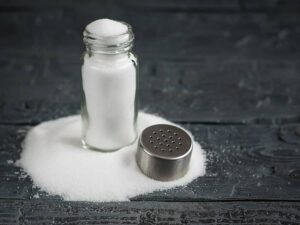
A lot of table salt labels brag about containing iodine, however, table salt isn't very good for you so it's better to consume iodine other ways.
Not so much.
I recommend that you avoid relying on (or even using) iodized salt, which contains a form of iodine known as potassium iodide. Iodized table salt is heavily processed23 to add the potassium iodide,21 stripped of vital trace elements, and contains dangerous preservatives like aluminum hydroxide and fluoride. It’s like sprinkling a bunch of chemicals on your food each time you eat a meal!
If you use salt, choose unprocessed pink Himalayan salt instead of traditional table salt. It’s free of all the chemical nasties, and although it doesn’t have as much iodine as artificially iodized salt, it does have some naturally occuring iodine.
How Much Iodine Do I Need for Optimal Health?
Clear back in 1930,22 scientists noted that nobody had ever determined the optimal level of iodine for human health. Amazingly enough, that’s still true today.
Exactly how much iodine you should add to your diet is a primarily a matter of your thyroid health. While most of us could benefit from extra iodine, individuals with thyroid conditions (like Hashimoto’s or hyperthyroidism) shouldn’t be taking any extra iodine without a doctor’s signoff.
It’s important to get your hormone levels tested (a complete panel, more on that below) to determine the state of your health. While most physicians and functional medicine providers agree that the FDA’s current limit is the absolute minimum needed to prevent goiters, the optimal amount of iodine consumption for good thyroid health is the subject of hot debate.
Personally, I try to match my intake with the average Japanese person’s iodine consumption,23 or about 1.2 mg. However, you should take your thyroid health, the results of your bloodwork, and your medical history into account.
If you’re hyperthyroid, hypothyroid, pregnant, or lactating, your iodine needs can differ quite a bit, and you should work closely with a well-qualified functional medical provider who can help you use iodine effectively.
How Will I Know if I’m Taking too Much Iodine?
Remember: Too much iodine can be just as problematic as too little iodine. And the perfect amount of iodine for someone with a healthy thyroid can differ drastically from someone with Hashimoto’s, or other thyroid conditions. Before you start supplementing with iodine, take steps to make sure your thyroid and endocrine system are healthy (more on testing below).
You should also make sure you’re very clear on the difference between milligrams (mg) and micrograms (mcg). One milligram contains one thousand micrograms. Take a careful look at labels, especially when you’re just getting started adding more iodine to your diet. You’re unlikely to overdo iodine by consuming iodine-rich foods, but some seaweeds and kelps are quite high in iodine.
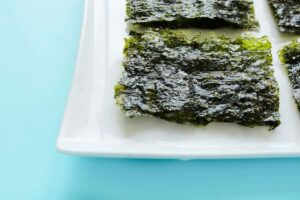
An amazing way to get a proper source of iodine is by consuming seaweed.
Basically, know what you’re eating, keep it plant-based, and keep your daily dosage near the safe upper limit of 1 mg (one milligram). As always, pay attention to your body’s signals. If you notice feelings of shakiness, jitters, or anxiety cropping up, you may need to dial down how much iodine you’re taking.
Note: Because it can be dangerous to supplement iodine on your own, consider doing so under the supervision of your medical practitioner.
Supplementing with Iodine
Most people can benefit from supplementing with iodine. There are a few basic options, some better than others!
Remember: Too much iodine is just as dangerous as not enough. And while the majority of practitioners agree with the National Institute of Health25 that 1100 mcgs (micrograms) of iodine is a safe upper limit, other practitioners feel that taking iodine supplements (in liquid or pill form) is risky.
Lugol’s Iodine
Lugol’s iodine is a concentrated solution of water and potassium iodine. It has a very high absorption rate by the body, and you’ll want to make sure your dosage is correct since you’re measuring in tiny drops!
Check with a natural hormone practitioner to determine your recommended dosage, possibly beginning with a very low, very conservative dose (one drop!), then gradually working your way up to your target dose (no more than six drops). I’m mildly hypothyroid, and 135 lbs., and they say I should take 5-6 drops of Lugol’s solution (and that if I notice my heart racing, I should back off the dose a little bit).
You can find Lugol’s iodine on the internet or health food stores.
Nascent Iodine
Nascent iodine is another liquid iodine supplement that’s extremely bioavailable (easy for the body to use and absorb. Keep in mind that there’s some misinformation floating around about nascent iodine (e.g., that it’s a “free form of iodine” unbound to other ions as a result of electromagnetic energy)
While that might be true at first, the iodine atoms immediately re-bond with any potassium or sodium ions (one or the other will be present in any liquid iodine supplement). In other words, nascent iodine is pretty similar to Lugol’s, and despite any aggressive marketing to the contrary, neither is particularly superior to the other.
Seaweed or Kelp
If you decide to try getting some iodine-rich foods in your diet, seaweeds like kelp and dulse are among your best options. They’re plant-based, organic, and hard to overdose with (although you should still make sure your dosage is right for your health, of course!). You can add powdered seaweed or kelp to your popcorn and soups as a salt substitute, because it’s salty--or you can even add a bit of it to your smoothies!
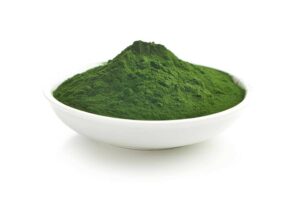
Swap your table salt for seaweed powder to be extra healthy.
Don’t be afraid when you see that most kelp, dulse or seaweed supplements have several times the daily recommended dose for iodine. Unlike Lugol’s/potassium iodide, your body absorbs about 37 percent of the iodine in kelp or seaweed.25 Make sure that if you’re taking kelp or seaweed capsules, you trust that the manufacturer is harvesting the kelp from clean waters, and verified free of toxic residue. Seaweeds from protected waters such as Iceland, Norway, Canada, the Northwest U.S., and Hawaii are less likely to be contaminated, so check labels before you purchase.
Multivitamin
A multivitamin really is not your best option24 for iodine (or anything else, for that matter). Did you know that most multivitamins contain animal products (gelatin), and even rocks (inorganic binders that hold the vitamin together, or sources of minerals that the body doesn’t even actually absorb)?
Multivitamins are also notorious for having too much of many nutrients and minerals, especially when combined with an even remotely healthy diet. Too much of some nutrients can be harmful.
And lastly, those chalky pills just aren’t very bioavailable to your cells. Get your vitamins and minerals (including iodine) from real food.
Important Minerals That Interact with Iodine
Keep in mind that while iodine is the gatekeeper to your thyroid health, it doesn’t work in a vacuum. It needs the right minerals to help your body absorb and use it. Make sure you’re getting enough of the following minerals on a daily basis:
- Calcium (leafy greens, chia seeds, almonds)
- Magnesium (avocado, legumes, whole grains, nuts)
- Copper (spirulina, mushrooms, leafy greens)
- Selenium (Brazil nuts, lentils, sunflower seeds, pecans)
- Zinc (hemp seeds, wild rice, lentils, wheat germ)
In fact, if you’re taking lots of iodine without these key minerals, you might be setting yourself up for thyroid issues.
Common Myths and Misconceptions About Iodine
There are quite a few persistent myths surrounding iodine, iodine deficiency, and even “iodine allergy”:
Myth 1: If You Have an Iodine Deficiency, You’ll Know It
The symptoms of moderate or mild iodine deficiency can be subtle. Tiredness, weight gain, stress, lots of hair in the shower drain, bags underneath the eyes, difficulty remembering things. Sound like anyone you know? Iodine deficiency can mimic PMS, menopause, perimenopause, or just stress in general. Most people who have an iodine deficiency don’t know it.
Myth 2: Most People Get Enough Iodine from Common Foods
If you live in Japan (and don’t eat a Western diet), this might be true. But for the rest of us, iodine deficiency is a real problem. Some doctors and nutritionists will insist that we get enough iodine from common foods (like iodized salt and potatoes), but given the problems of iodized salt (low bioavailability, highly processed, and chemicalized) and the relatively low levels of iodine in food that doesn’t come from the sea, it’s more accurate to say that the amount of iodine the average person gets each day is sufficient only to keep goiters at bay.
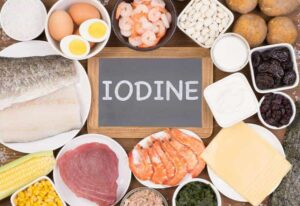
Food that is rich in iodine is not usually found in a typical western diet.
Myth 3: Cruciferous Vegetables Like Kale Will Hurt My Iodine Levels
Have you heard the myth that cruciferous greens and veggies will give you a goiter and hurt your thyroid25? It’s not a total myth — technically, kale CAN give you a goiter, just like apple seeds CAN give you arsenic poisoning.
But just like you’d have to eat about 40 apples cores to get arsenic poisoning, the average person would have to eat an unsustainable amount of kale and broccoli to start worrying about your thyroid health and iodine levels. Given that kale and broccoli are not addictive, there’s approximately a zero percent chance you’ll “overdose!”
Kale, broccoli, and cabbage have a lot of thyroid-nourishing properties, not to mention anti-cancer properties. Don’t fall for the “cook it to neutralize it” either, or you’re going to miss out on a lot of vitamins, minerals, and living enzymes.
Use common sense and eat a balanced diet that includes a variety of fresh vegetables!
Myth 4: Iodized Salt Is a Good Source of Iodine
Again, iodized salt does contain iodine. But it’s not a “good” source my any means. Iodized table salt is heavily processed,23 not to mention filled with dangerous preservatives like aluminum hydroxide and fluoride (coincidentally an endocrine disruptor that can make it difficult for your thyroid to absorb iodine).
Myth 5: Taking Iodine Can Cause Thyroid Problems
The amount of iodine Americans consume has gone down steadily over the past forty years. If iodine were responsible for thyroid disorders, you’d expect to see those numbers go down too. But just the opposite has happened — thyroid disease is on the rise.
Taking too much iodine, or too little iodine can cause thyroid problems, wreak havoc on your endocrine system, and do a number on your metabolism. Just the right amount is critical for thyroid health. Remember, don’t start supplementing rigorously without getting a full hormone panel by a trusted functional medicine doctor.
Myth 6: More Is Iodine Is Better
We covered this pretty well in myth 5, but it’s worth reiterating. Taking more iodine than the standard American diet provides is usually a really good thing. But taking more iodine than your naturopath or functional medicine provider recommends can be dangerous. Use common sense and don’t pop kelp pills like candy!
Myth 7: Some People Have an Iodine Allergy
A dye that contains iodine is sometimes used to help doctors interpret X-ray results more easily in cancer patients.
While it’s true that some people do have a reaction to this dye, iodine isn’t the culprit (and neither is the dye, for that matter). Doctors believe that the dye can cause a sudden shift in the water/electrolyte balance in some cells, mimicking a (sometimes severe) allergic reaction, including hives or difficulty breathing due to swollen airways.

Some people get what looks like an allergic reaction when their skin is exposed to iodine solutions.
Part of the reason this myth got started is because seafood (which contains iodine) does sometimes cause a real allergic reaction (but not because of iodine).
While there are reports of something called “iodism,” or a bad reaction to iodine supplements that included a brassy taste in the mouth, headache, and sneezing, most modern doctors agree that this reaction most likely came from small amounts of bromine in iodine solutions of yore.26
How to Test Your Iodine Levels
Health practitioners will usually recommend one (or more) of the following tests to determine your iodine levels:
- Simple urine test: While quick and easy, this test only gives a single snapshot of iodine levels in the urine (excess iodine is excreted in the urine).
- 24-hour urine test: This test more accurate but likewise more complicated, since it requires testing ALL urine samples over a 24-hour period. Your doctor will administer a relatively high dose of iodine, then measure how much your body excretes. If you excrete very little, you’re considered very iodine deficient (since your thyroid is trying to hold onto all the iodine it can get).
- Blood test: More accurate than a urine test, but the results take longer and are more complicated to read.
Keep in mind that most MDs accept very low iodine levels as “normal,” in keeping with current FDA guidelines for iodine consumption. In other words, take a “normal” result with a grain of salt (non-iodized, please!). See a qualified naturopath or functional medicine provider who is well-versed in the latest research on optimal iodine levels.
It’s also important to understand that all of these tests give you just one data point: an approximate idea of whether or not you’re getting enough iodine. They don’t really tell you how well your thyroid is working — and that information is critical!
How to Test Your Thyroid Health
Getting a baseline of your thyroid and hormone health is critical, especially if you’re considering supplementing with iodine.
If you tell most MDs that you want to test your thyroid function, you’ll be given a blood test that looks at TSH levels (thyroid stimulating hormones, which tell your thyroid to produce hormones). And if those results are abnormal, your doctor will likely look at T3 (triiodothyronine) and T4 levels (thyroxine).
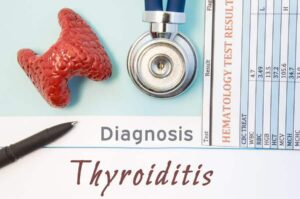
If you're considering taking iodine supplements, make sure that your thyroid will not be harmed by doing so.
While iodine levels, TSH levels, and T3/T4 levels are a good place to start, I recommend a full blood panel test with a natural hormone practitioner, to get a complete picture of the factors happening upstream and downstream in your endocrine system.
Your thyroid doesn’t operate in a vacuum, and a good practitioner can help you analyze the interplay of your entire endocrine system, then make proper recommendations.
[Related: 9 Questions For Your Natural Hormone Replacement Practitioner]
Summary: Why Iodine Matters
Iodine is, indeed, a “necessary ingredient,” vital to thyroid health, brain development, healthy hair and nails, proper reproductive function, and hormone production. But unfortunately, one third of us are deficient in this important element because of the relatively few foods that contain iodine, and some pervasive myths about how much iodine we really need. Getting tested for iodine levels and thyroid function, eating enough iodine-rich foods, and supplementing when necessary is one of the easiest ways for most people to improve their overall health.
Read next: Endocrine Disruptors: 14 Common Chemicals That Can Disrupt Your Hormones

Disclosure: This post may contain affiliate links that help support the GSG mission without costing you extra. I recommend only companies and products that I use myself.
Resources
- Editorial: What’s Happening to Our Iodine? J. Clinical Endocrinology and Metabolism, 33:3398-3400, 1998.
- American Thyroid Association, General Information, www.thyroid.org, accessed 1/23/2019.
- World Health Organization, Micronutrient Deficiencies, www.who.int, accessed 1/22/2019.
- Nyaradi A, Li J, Hickling S, Foster J, Oddy WH. The role of nutrition in children's neurocognitive development, from pregnancy through childhood. Front Hum Neurosci. 2013;7:97. Published 2013 Mar 26. doi:10.3389/fnhum.2013.00097
- Nussey S, Whitehead S. Endocrinology: An Integrated Approach. Oxford: BIOS Scientific Publishers; 2001. Chapter 3, The thyroid gland.Available from: link
- Puppel id, Curtis gm. Calcium and Iodine Metabolism in Thyroid Disease. Arch Intern Med (Chic). 1936;58(6):957–977. doi:10.1001/archinte.1936.00170160003001
- Mahmoud Hashemi H, Mohammadi F, Hasheminasab M, Mahmoud Hashemi A, Zahraei S, Mahmoud Hashemi T. Effect of low-concentration povidone iodine on postoperative complications after third molar surgery: a pilot split-mouth study. J OralMaxillofac Surg. 2015 Jan;73(1):18-21. doi: 10.1016
- Survivopedia, How to Purify Water with Iodine for Survival, www.survivopedia.com, accessed 1/20/2019
- Venturi S, Donati FM, Venturi A, Venturi M, Grossi L, Guidi A. Role of iodine in evolution and carcinogenesis of thyroid, breast and stomach. Adv Clin Path. 2000 Jan;4(1):11-7
- Frith, John. Syphilis — Its Early History and Treatment Until Penicillin and the Debate on its Origins.” Journal of Military and Veterans Health, Volume 20 No. 4.
- Duntas, L.H. Endocrine (2015) 48: 53. https://doi.org/10.1007/s12020-014-0442-4
- United States Nuclear Regulatory Commission, Frequently Asked Questions About Potassium Iodide, www.nrc.gov, accessed 1/19/2019.
- Schmut O, Horwath-Winter J, Rieger G, Winkler R, Trummer G, Spitzenberger H, Wachswender C. Iodide protection from UVB irradiation-induced degradation of hyaluronate and against UVB-damage of human conjunctival fibroblasts. Graefes Arch Clin Exp Ophthalmol. 2004 Apr;242(4):279-83.
- EMF Academy, Best Supplements and Minerals for EMF Protection, www.emfacademy.com, accessed 1/20/2019.
- Schroeder, A and Prvalski, M. Thyroid Hormones T3 and T4 in the Brain. Front Endocrinol 2014; 5:40..
- Dfarhud, D, Malmir, M, and Khanahmadi, M. Happiness and Health: the Biological Factors--Systematic Review. Iran J Public Health. 2014 Nov; 43(11): 1468-1477
- Manel Puig-Domingo and Lluis Vila, “The Implications of Iodine and its Supplementation During Pregnancy in Fetal Brain Development”, Current Clinical Pharmacology (2013) 8: 97.
- Rappaport J. Changes in Dietary Iodine Explains Increasing Incidence of Breast Cancer with Distant Involvement in Young Women. J Cancer. 2017;8(2):174–177. Published 2017 Jan 13. doi:10.7150/jca.17835
- Dr. Edward Group DC, NP, DACBN, DCBCN, DABFM. Iodine and Polycystic Ovary Syndrome (PCOS): What You Need to Know.” Global Healing Center. Feb. 25, 2015.
- Gulaboglu M, Borekci B, Delibas I. Urine iodine levels in preeclamptic and normal pregnant women. Biol Trace Elem Res (2010) 136:249–57.10.1007/s12011-009-8539-y
- Smyth PP. The thyroid, iodine and breast cancer. Breast Cancer Res. 2003;5(5):235-8.
- Takeuchi T, Kamasaki H, Hotsubo T, Tsutsumi H. Treatment of Hypothyroidism due to Iodine Deficiency Using Daily Powdered Kelp in Patients Receiving Long-term Total Enteral Nutrition. Clin Pediatr Endocrinol. 2011;20(3):51-5.
- Dr. Edward Group DC, NP, DACBN, DCBCN, DABFM, “The Health Dangers of Table Salt.” Global Healing Center, January 24, 2017.
- Thompson, W.O., Brailey, A.G., Thompson, P.K., et al, the Range of Effective Iodine Dosage in Exophthalmic Goiter. Arch. Int. Med., 45:261-281, 1930.
- Nagataki S. The average of dietary iodine intake due to the ingestion of seaweeds is 1.2 mg/day in Japan. Thyroid. 2008 Jun;18(6):667-8. doi:10.1089/thy.2007.0379. PubMed PMID: 18578621.
- Iodine Fact Sheet for Health Professionals, National Institutes of Health. Accessed May 21, 2019.
- Peacock, L., Davison, H., Observations on Iodide Sensitivity. Ann. Allerg., 15:158-164, 1957.
Posted in: Detox, Health Concerns, Holistic Care, Lifestyle, Natural Products, Natural Remedies, Supplements, Whole Food





